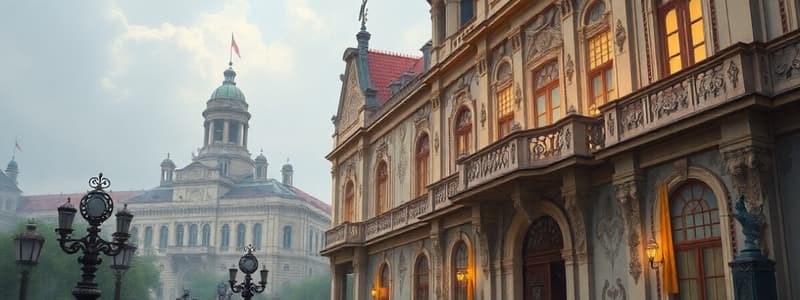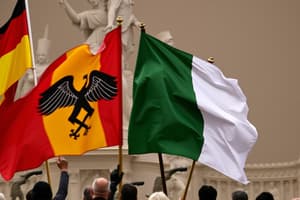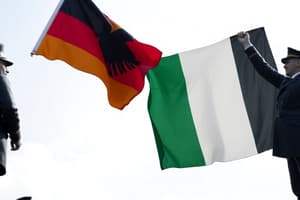Podcast
Questions and Answers
How did nationalism serve as both a unifying and disunifying force in Italy?
How did nationalism serve as both a unifying and disunifying force in Italy?
- It uniformly strengthened the central government and weakened local identities.
- It promoted cultural unity while fostering regional rivalries. (correct)
- It solely focused on military expansion, ignoring local sentiments.
- It led to economic prosperity and reduced regional independence.
What was a significant challenge faced by the Austrian, Russian, and Ottoman Empires in maintaining control over their territories?
What was a significant challenge faced by the Austrian, Russian, and Ottoman Empires in maintaining control over their territories?
- The rise of global trade routes diminishing their influence.
- The emergence of nationalist movements demanding independence. (correct)
- The decentralization of power within their political systems.
- The reduction of military technology leading to weakened defenses.
What advantages did Prussia have in leading the unification of the German states?
What advantages did Prussia have in leading the unification of the German states?
- A smaller population making it easier to govern.
- Widespread support from other European nations.
- Economic dominance and a powerful military. (correct)
- A lack of competing regional identities among its citizens.
How did Bismarck's approach to achieving political goals differ from that of contemporary liberals?
How did Bismarck's approach to achieving political goals differ from that of contemporary liberals?
What role did Garibaldi play in the unification of Italy?
What role did Garibaldi play in the unification of Italy?
What characterizes a unification nationalist movement?
What characterizes a unification nationalist movement?
Which of the following is an example of a separation nationalist movement?
Which of the following is an example of a separation nationalist movement?
For state-building to occur, which factor must be present?
For state-building to occur, which factor must be present?
What common factor threatened the stability of three major empires in the 19th century?
What common factor threatened the stability of three major empires in the 19th century?
Which statement best describes state-building nationalist movements?
Which statement best describes state-building nationalist movements?
Which nationalist movement type exemplifies the merging of regions to form a unified state?
Which nationalist movement type exemplifies the merging of regions to form a unified state?
What was a likely result of the nationalist movements seen in the 19th century?
What was a likely result of the nationalist movements seen in the 19th century?
Which is NOT a characteristic of separation nationalist movements?
Which is NOT a characteristic of separation nationalist movements?
What event prompted Prussia to gain control of the North German Confederation?
What event prompted Prussia to gain control of the North German Confederation?
What was one consequence of Emperor Francis Joseph declaring Austria and Hungary independent states?
What was one consequence of Emperor Francis Joseph declaring Austria and Hungary independent states?
What was the primary goal of the Russification policy implemented by the Romanov dynasty?
What was the primary goal of the Russification policy implemented by the Romanov dynasty?
Who ruled over the largest population within the Russian Empire aside from Russians?
Who ruled over the largest population within the Russian Empire aside from Russians?
What was the reaction of conservative Turks to the equal citizenship policy granted by the Ottomans in 1856?
What was the reaction of conservative Turks to the equal citizenship policy granted by the Ottomans in 1856?
What was the impact of the nationalist disputes within the Austro-Hungarian Empire?
What was the impact of the nationalist disputes within the Austro-Hungarian Empire?
Which empire faced disunity as a consequence of its policy of Russification?
Which empire faced disunity as a consequence of its policy of Russification?
What historical event ultimately contributed to the collapse of the czarist regime in Russia?
What historical event ultimately contributed to the collapse of the czarist regime in Russia?
What significant event occurred in Armenia during the years 1894 to 1896?
What significant event occurred in Armenia during the years 1894 to 1896?
Who was named prime minister of Sardinia in 1852?
Who was named prime minister of Sardinia in 1852?
What was the primary goal of Camillo di Cavour as prime minister?
What was the primary goal of Camillo di Cavour as prime minister?
What was a consequence of nationalism in the context of the Ottoman Empire?
What was a consequence of nationalism in the context of the Ottoman Empire?
Which country posed the greatest roadblock to Cavour's plans?
Which country posed the greatest roadblock to Cavour's plans?
Which kingdom played a pivotal role in the Italian unification efforts?
Which kingdom played a pivotal role in the Italian unification efforts?
Which concept did Italian nationalists primarily seek from foreign rulers?
Which concept did Italian nationalists primarily seek from foreign rulers?
In what year did Cavour provoke a war with Austria?
In what year did Cavour provoke a war with Austria?
By what year were fewer Italians content to live under foreign rulers, signaling a rise in nationalism?
By what year were fewer Italians content to live under foreign rulers, signaling a rise in nationalism?
What significant outcome resulted from the combined French-Sardinian army's victories?
What significant outcome resulted from the combined French-Sardinian army's victories?
What type of constitution did the kingdom of Piedmont-Sardinia adopt in 1848?
What type of constitution did the kingdom of Piedmont-Sardinia adopt in 1848?
Who was the French emperor that allied with Cavour during the conflict with Austria?
Who was the French emperor that allied with Cavour during the conflict with Austria?
What method did Cavour primarily use to expand his power?
What method did Cavour primarily use to expand his power?
In what year did Armenians experience significant violence during World War I?
In what year did Armenians experience significant violence during World War I?
What was the general attitude of Italians towards living under foreign rule by the time nationalism rose in the 19th century?
What was the general attitude of Italians towards living under foreign rule by the time nationalism rose in the 19th century?
What was the significance of the victories achieved by Cavour's forces?
What was the significance of the victories achieved by Cavour's forces?
What significant event occurred between 1858 and 1870 in the context of Italian unification?
What significant event occurred between 1858 and 1870 in the context of Italian unification?
Which territory did the Italians acquire in the period between 1859 and 1860?
Which territory did the Italians acquire in the period between 1859 and 1860?
What role did Cavour play in the unification of Italy?
What role did Cavour play in the unification of Italy?
Which region was lost to France during the Italian unification process?
Which region was lost to France during the Italian unification process?
During which year was the Austrian province of Venetia unified with Italy?
During which year was the Austrian province of Venetia unified with Italy?
Who was referred to as 'The Red One' during the Italian unification?
Who was referred to as 'The Red One' during the Italian unification?
What was the result of the political maneuvering between Cavour and Garibaldi?
What was the result of the political maneuvering between Cavour and Garibaldi?
What major political change occurred as a result of the unification?
What major political change occurred as a result of the unification?
Flashcards
Unification
Unification
A type of nationalist movement that unites culturally similar but politically divided lands into a single nation-state.
Separation
Separation
A type of nationalist movement where a culturally distinct group seeks to separate from a larger state or resist being incorporated into one.
State-building
State-building
A type of nationalist movement where culturally diverse groups unite to form a new nation-state.
Unification: Characteristics
Unification: Characteristics
Signup and view all the flashcards
Separation: Characteristics
Separation: Characteristics
Signup and view all the flashcards
State-building: Characteristics
State-building: Characteristics
Signup and view all the flashcards
Unification: Examples
Unification: Examples
Signup and view all the flashcards
Separation: Examples
Separation: Examples
Signup and view all the flashcards
Austria-Hungary
Austria-Hungary
Signup and view all the flashcards
Austro-Prussian War
Austro-Prussian War
Signup and view all the flashcards
Ottoman Empire
Ottoman Empire
Signup and view all the flashcards
Empire Breakup
Empire Breakup
Signup and view all the flashcards
Nationalism
Nationalism
Signup and view all the flashcards
Empire Weakening
Empire Weakening
Signup and view all the flashcards
Russian Empire
Russian Empire
Signup and view all the flashcards
Genocide
Genocide
Signup and view all the flashcards
Piedmont-Sardinia
Piedmont-Sardinia
Signup and view all the flashcards
Liberalism
Liberalism
Signup and view all the flashcards
Constitutionalism
Constitutionalism
Signup and view all the flashcards
Unification of Italy
Unification of Italy
Signup and view all the flashcards
Italian Peninsula
Italian Peninsula
Signup and view all the flashcards
Period of Italian Unification (1859-1870)
Period of Italian Unification (1859-1870)
Signup and view all the flashcards
Role of Piedmont-Sardinia in Italian Unification
Role of Piedmont-Sardinia in Italian Unification
Signup and view all the flashcards
Garibaldi's Role in Unifying Southern Italy
Garibaldi's Role in Unifying Southern Italy
Signup and view all the flashcards
Addition of Venetia to Italy
Addition of Venetia to Italy
Signup and view all the flashcards
Absorption of Papal States into Italy
Absorption of Papal States into Italy
Signup and view all the flashcards
Garibaldi's Agreement with Victor Emmanuel II
Garibaldi's Agreement with Victor Emmanuel II
Signup and view all the flashcards
Camillo di Cavour
Camillo di Cavour
Signup and view all the flashcards
Nationalism: Unifying and Disunifying Force
Nationalism: Unifying and Disunifying Force
Signup and view all the flashcards
Victor Emmanuel II
Victor Emmanuel II
Signup and view all the flashcards
Garibaldi's Role in Unification
Garibaldi's Role in Unification
Signup and view all the flashcards
Cavour's Strategic Role in Italian Unification
Cavour's Strategic Role in Italian Unification
Signup and view all the flashcards
Austria
Austria
Signup and view all the flashcards
Napoleon III
Napoleon III
Signup and view all the flashcards
Challenges to Empires: Nationalism
Challenges to Empires: Nationalism
Signup and view all the flashcards
Bismarck's 'Realpolitik' vs. Liberalism
Bismarck's 'Realpolitik' vs. Liberalism
Signup and view all the flashcards
Italian Unification
Italian Unification
Signup and view all the flashcards
Northern Italy
Northern Italy
Signup and view all the flashcards
Alliances
Alliances
Signup and view all the flashcards




